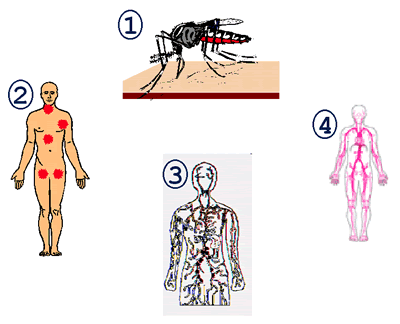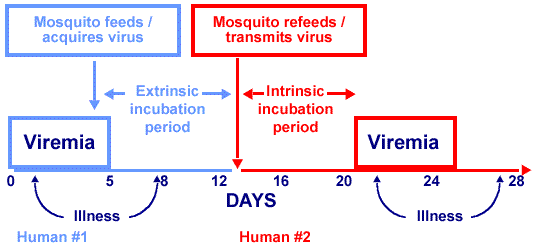Dengue Virus
| Dengue Virus | ||||||
|---|---|---|---|---|---|---|
 | ||||||
| Virus classification | ||||||
|
Description and significance:
The Dengue Virus, pronounced as [deng – gey or deng – gee] is a category-A pathogen and therefore is a serious threat to the human population globally. Category A pathogens are microbes that are hazardous to lab personnel and have the potential to cause serious epidemic disease. The Dengue Virus has four different serotypes, DEN-1, DEN-2, DEN-3 and DEN-4. These four serotypes are approximately 60-80% homologous but different enough to restrict cross immunity. This means that if a person is infected with one type of the four Dengue virus serotypes, they will build immunity to that specific serotype, but not for the other three. This lack of cross immunity is what poses a problem in the development of a vaccine for Dengue. The Dengue virus causes a less lethal condition known as Dengue Fever, which is also known as the breakbone fever. The Dengue virus causes a more lethal condition in some who are infected and that is known as the Dengue Hemorrhagic Fever (DHF) and Dengue Shock Syndrome (DHS).
The Dengue virus is currently believed to be the most common mosquito-borne disease in recent times and cause for increased international health concerns. The Dengue virus currently poses a risk to approximately 2.5 billion people of the worlds total population. In other words, almost one third of the world is at risk for this potentially deadly virus. The Dengue virus is transmitted amongst humans via its main vector, the Aedes aegypti mosquito. This virus is mostly found in countries along the equator and in countries with tropical and subtropical conditions because these are the conditions needed for this mosquito to thrive in. The mosquito acquires the disease from an infected individual and then carries it and passes it on to other individuals it feeds off of. Once an individual has been infected the virus then causes the person to come down with Dengue Fever. Dengue fever is a febrile disease and has Flu like symptoms accompanied by a rash and severe aches and pains. Headaches are extremely common and stronger than normal. Joint pain is also very common. Dengue Fever will usually subside in approximately five to ten days. Dengue Hemorrhagic Fever is the more serious complication caused by the Dengue Virus. Dengue Hemorrhagic Fever has an incubation period that is similar to Dengue Fever (approximately 3-5 days) but unless treated with a combination of corticosteroids, proper hydration and physician supervision, DHF will be mortal for the individual. Dengue Hemorrhagic Fever causes the blood vessels to become excessively permeable accompanied by thrombocytopenia and abnormal hemostasis.
Natural Host and Transmission Cycle:
The Dengue virus has a host cycle of Human-Aedes aegypti-Human, where the human acts as a host and reservoir for this virus and the mosquito is the primary and extremely efficient vector. The initial host for this virus is the infected human. When a female A. aegypti mosquito feeds on the infected human she bites into the blood stream of the human and injects an anticoagulant into the blood. While she is feeding, the virus is transmitted to the mosquito. The virus then replicates within the mosquito and is transmitted to the next human that she feeds upon while injecting it with the anticoagulant. The mosquito primarily functions as an effective vector but also plays host in between transmission because this is where the acquired Dengue virus serotype is being replicated prior to being injected into the next human victim.
1. Female Mosquito bites infected human and contracts the virus.
2. Female mosquito bites and infects another human and begins to replicate.
3. Virus infects white blood cells and lymphatic tissues.
4. The virus is released and circulates into the blood.
When was the Dengue Virus discovered?
An encyclopedia of disease symptoms and remedies from the Chin Dynasty contains the earliest possible records of the Dengue virus. The encyclopedia was originally written around 265 to 420 and was formally edited in 610 A.D. under the Tang Dynasty and then again in 992 A.D. under the Northern Sung Dynasty. The disease that the Chinese were talking about was called “water poison” and was thought to be somehow connected with flying insects that were associated with the water.
Dr. Benjamin Rush discovered, identified and documented the first case of Dengue Fever back in 1779. Dr. Rush is the person responsible for calling it the “breakbone” fever. During the timeframe of 1779-1780 the first of multiple Dengue Fever reports were recorded across Asia, Africa and North America. Dengue Fever was a known disease in North America back in that time but in more modern times, outbreaks of Dengue has not been too significant. The only recorded occurrences of Dengue via the Aegypti mosquito has only been recorded six times since 1975 in the state of Texas.
How and where it was isolated:
In more recent times, cases of Dengue have been isolated from Pakistan to the Americas. The first ever Dengue viruses were isolated from soldiers who fell sick in Calcutta, India, New Guinea and Hawaii. The viruses from India, Hawaii and one serotype from New Guinea were Antigenically similar, whereas three other serotypes from New Guinea appeared to be different. They were called Dengue 1 (DEN-1) and Dengue 2 (DEN2) and designated as prototype viruses (DEN-1, Hawaii and DEN-2, New Guinea-C). Two more serotypes - Dengue 3 (DEN-3) and Dengue 4 (DEN-4) were subsequently isolated from patients with a hemorrhagic disease during an epidemic in Manila in 1956.
Interesting Features and Facts:
Dengue Virus is not a single virus it has four different Serotypes.
- DEN-1, DEN-2, DEN-3, DEN-4
It cannot be transmitted by any of the following
- Saliva
- Hugging
- Handshaking
- Breathing
- Sexual Intercourse
- Human to Human transmission has not yet been discovered
It can only be transmitted via its small yet efficient vector, the female Aedes aegypti
Being infected the first time may cause Dengue Fever with any of the four serotypes and the infected body may develop immunity to that specific serotype. Infection a second time by any of the remaining three will cause Dengue Hemorrhagic Fever.
Vaccines have been developed but none have worked to provide cross immunity against all four serotypes in order for them to be successful. Technology and tools to perform Dengue Virus tests on the Aedes aegypti do not exist as of yet.
How does the Dengue Virus cause disease?
The problems of Dengue virus begins when the mosquito Aedes aegypti feeds blood from a Dengue infected person. This person has to have the virus circulating in their blood stream when the mosquito sucks blood. After the mosquito contracts the virus from the infected human host, the virus then replicates within the mosquito during an extrinsic incubation period of eight to twelve days. The mosquito then bites into the blood stream of its next human blood meal and infects that person with the Dengue virus as well as every other person the mosquito bites in her lifetime. Once the second person has been infected, the virus begins to replicate within their body and also begins to show symptoms four to seven days on average and three to fourteen in some cases after the mosquito bit them. The person now begins to develop Dengue Fever and the symptoms are severe muscle and joint pain accompanied by severe headaches. The symptoms of Dengue are similar to the Flu. Once the infected human recovers from the Dengue Fever, they are immune to that one serotype of Dengue, for life. If another mosquito carrying a different serotype ever infects this same person, they will then develop what is known as Dengue Hemorrhagic Fever, this is the more lethal form of Dengue Fever. In DHF, the person will show all of the symptoms of DF but will also begin to bleed internally. Bleeding will be noticed easily inside the eyes and inside the limbs. The victim will eventually succumb to the bleeding and the pain and die if not under the care of a trained physician.
What makes Dengue biologically interesting?
Why should a disease from the third world, underdeveloped and tropical regions of this world bother anyone not near the affected regions?
What makes the Dengue virus so very interesting is that only around 200 years ago, it was a rare and isolated situation of someone dying of Dengue Fever or Dengue Hemorrhagic Fever. Today, this virus puts over 2.5 billion, that’s approximately one-third of the global population at risk. The major spread of this disease happened in this century after World War II when soldiers who had it were moved around. It is interesting to know that so little is known about this virus or its multiple serotypes because the proper technology does not exist to carry out the required experiments on the Aedes aegypti. It’s also interesting to know that resistance to one strain does not mean nor permit resistance to the other remaining three strains, leaving the victim vulnerable to now developing Dengue Hemorrhagic Fever with no clear cut treatment available.
Current Research:
1. Comparison of Plaque- and Flow Cytometry-Based Methods for Measuring Dengue Virus Neutralization
Research and development in the field of Dengue vaccines is ongoing and as the vaccines enter clinical trials neutralization has to be measured quantitatively, rapidly and accurately. These researchers and scientists have developed methods to generate results that are similar to plaque reduction, already established, by using flow-based neutralization assays. The flow-based assays are an improvement over the established method because they utilize human cells and permit for high-throughput screening.
2. Molecular epidemiology of dengue type 2 virus in Venezuela: evidence for in situ virus evolution and recombination
This research shows that the Dengue Fever outbreak in 1978 and the Dengue Hemorrhagic Fever in 1989 in Venezuela have ties to the Asian strain of the virus. The virus currently present in Venezuela has evolved in-situ.
3. Chest Radiographic Presentation in Patients with Dengue Hemorrhagic Fever
A retrospective study was performed on 363 DHF patients from southern Taiwan. After reviewing 468 CXRs more than half showed abnormalities after 3 days. The major findings of the review were pleural effusions and infiltration. During the first week abnormalities were presented and during the second week recovery was evident. Correlations were found in between the CXRs and laboratory results and ultimate outcome of the patient’s condition. This research shows that the CXR may be an utilizable tool in evaluating DHF and must be done in the first week after the illness presents itself.
References:
http://cmr.asm.org/cgi/content/full/11/3/480?view=long&pmid=9665979
http://pathport.vbi.vt.edu/pathinfo/pathogens/Dengue1.html
http://www.flickr.com/photos/ajc1/1437910835/
http://www.ihcworld.com/royellis/ABCSafe/glossary/category-a-pathogens.htm
http://www.stanford.edu/group/virus/flavi/2000/dengue.htm
http://www.who.int/csr/disease/dengue/en/
http://www.cdc.gov/ncidod/dvbid/dengue/
http://www.who.int/topics/dengue/en/
http://cmr.asm.org/cgi/content/full/11/3/480?view=long&pmid=9665979
http://www.ehow.com/about_4597883_who-discovered-dengue-fever.html
http://www.cdc.gov/ncidod/dvbid/dengue/index.htm#history
http://www.cdc.gov/ncidod/dvbid/dengue/slideset/set1/i/slide04.htm
http://www.cdc.gov/ncidod/dvbid/dengue/slideset/set1/i/slide05.htm

